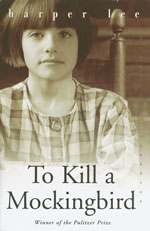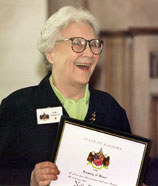About the Book

The unforgettable novel of childhood in a sleepy Southern town and the crisis of conscience that rocked it, “To Kill a Mockingbird” became both an instant bestseller and a critical success when it was first published in 1960. It went on to win the Putlizer prize in 1961 and was later made into an Academy Award-winning film, also a classic.
Compassionate, dramatic, and deeply moving, “To Kill a Mockingbird” takes readers to the roots of human behavior—to innocence and experience, kindness and cruelty, love and hatred, humor and pathos. Now with over 15 million copies in print and translated into forty languages, this regional story by a young Alabama woman claims universal appeal. Harper Lee always considered her book to be a simple love story. Today it is regarded as a masterpiece of American literature.
–from To Kill A Mockingbird, Warner Books Edition
Set in the small Southern town of Maycomb, Alabama, during the Depression, "To Kill a Mockingbird" follows three years in the life of 8-year-old Scout Finch, her brother, Jem, and their father, Atticus–three years punctuated by the arrest and eventual trial of a young black man accused of raping a white woman. Though her story explores big themes, Harper Lee chooses to tell it through the eyes of a child. The result is a tough and tender novel of race, class, justice, and the pain of growing up.
Like the slow-moving occupants of her fictional town, Lee takes her time getting to the heart of her tale; we first meet the Finches the summer before Scout’s first year at school. She, her brother, and Dill Harris, a boy who spends the summers with his aunt in Maycomb, while away the hours reenacting scenes from Dracula and plotting ways to get a peek at the town bogeyman, Boo Radley. At first the circumstances surrounding the alleged rape of Mayella Ewell, the daughter of a drunk and violent white farmer, barely penetrate the children’s consciousness. Then Atticus is called on to defend the accused, Tom Robinson, and soon Scout and Jem find themselves caught up in events beyond their understanding. During the trial, the town exhibits its ugly side, but Lee offers plenty of counterbalance as well–in the struggle of an elderly woman to overcome her morphine habit before she dies; in the heroism of Atticus Finch, standing up for what he knows is right; and finally in Scout’s hard-won understanding that most people are essentially kind "when you really see them." By turns funny, wise, and heartbreaking, "To Kill a Mockingbird" is one classic that continues to speak to new generations, and deserves to be reread often.
–Alix Wilber (Amazon.com)
About the Author

Harper Lee is an elusive figure. Since the publication of her first and only (known) novel, she has carefully guarded her privacy and does not give interviews. She was born Nelle Harper Lee on April 28, 1926 in Monroeville, Alabama. Her parents were Amasa Coleman Lee and Frances Finch Lee, and she is the youngest of four children, including two sisters and a brother. She went to Huntingdon College and the University of Alabama, where she studied law. Though her father and older sister, Alice, were lawyers, Lee herself left law school before finishing her degree. In the 1950s she worked as an airline clerk in New York City, and in 1957 she submitted the manuscript of a novel to Lippincott. For the next several years she revised this manuscript, and in 1960 “To Kill a Mockingbird” was published. She won the Pulitzer Prize in 1961 and was named by President Lyndon Johnson to the National Council of Arts in 1966.
In 1959, she went with her childhood friend Truman Capote (on whom the character Dill Harris is said to be based) to Kansas as a research assistant for the book that would become In Cold Blood (1966). Capote dedicated the book partially to her, and invited Lee to what has become one of the most famous parties of the twentieth century — his glamorous Black and White ball in honor of Katherine Graham.
In 1962, the movie “To Kill a Mockingbird” was released. The screenplay was written by Horton Foote, and Gregory Peck went on to win a Best Actor Oscar for his portrayal of Atticus Finch. In a rare interview with Roy Newquist (published in Counterpoint, Rand McNally, 1964), Lee said “I have nothing but gratitude for the people who made the film…. I’m no judge, and the only film I’ve ever seen made was “Mockingbird,” but there seemed to be an aura of good feeling on the set.” She said that at first, though she liked Gregory Peck when she met him, she was unsure that he was right for the part. However, when she saw him in costume, she said “I knew everything was going to be all right because he was Atticus.”
Since it first appeared in 1960, “To Kill a Mockingbird” has never been out of print and is considered a classic all over the world. In recent years, Lee has split her time between New York and Monroeville, where she lives with her sister. Aside from her famous novel, Harper Lee has written only four essays for publication. Many speculate that she has written books under another name or that she has been working on her memoirs or other novels, but there is no confirmation of these rumors. However, it is hard to believe that Harper Lee has given up writing. In her interview with Newquist, she said “You know, many writers really don’t like to write…. I like to write. Sometimes I’m afraid that I like it too much because when I get into work I don’t want to leave it. As a result I’ll go for days and days without leaving the house or wherever I happen to be. I’ll go out long enough to get papers and pick up some food and that’s it. It’s strange, but instead of hating writing I love it too much.”
-from NoveList Book Discussion Guides/EBSCO Publishing © 2001
